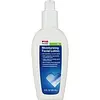What's inside
What's inside
 Key Ingredients
Key Ingredients

 Benefits
Benefits

 Concerns
Concerns

 Ingredients Side-by-side
Ingredients Side-by-side

Water
Skin ConditioningEthylhexyl Palmitate
EmollientGlycerin
HumectantPetrolatum
EmollientCetyl Alcohol
EmollientCetearyl Alcohol
EmollientIsopropyl Myristate
EmollientGlyceryl Stearate
EmollientPhenoxyethanol
PreservativeTriethanolamine
BufferingCeteth-10 Phosphate
CleansingDicetyl Phosphate
EmulsifyingCarbomer
Emulsion StabilisingParfum
MaskingMethylparaben
PreservativeAllantoin
Skin ConditioningBenzophenone-4
UV AbsorberButyrospermum Parkii Butter
Skin ConditioningDimethicone
EmollientMangifera Indica Seed Butter
Skin ConditioningPersea Gratissima Oil
Skin ConditioningPropylparaben
PreservativeTheobroma Cacao Seed Butter
EmollientDisodium EDTA
PEG-8 Dimethicone
EmulsifyingCarica Papaya Fruit Extract
Skin ConditioningColocasia Antiquorum Root Extract
Skin ConditioningMangifera Indica Fruit Extract
Skin ConditioningPassiflora Incarnata Fruit Extract
Skin ConditioningPlumeria Acutifolia Flower Extract
Skin ConditioningPsidium Guajava Fruit Extract
AstringentAloe Barbadensis Leaf Juice Powder
Skin ConditioningOctyldodecanol
EmollientRetinyl Palmitate
Skin ConditioningSilica
AbrasiveTocopheryl Acetate
AntioxidantAscorbic Acid
AntioxidantSodium Propoxyhydroxypropyl Thiosulfate Silica
Solvent Yellow 33
Camellia Sinensis Leaf Extract
AntimicrobialCI 17200
Cosmetic ColorantWater, Ethylhexyl Palmitate, Glycerin, Petrolatum, Cetyl Alcohol, Cetearyl Alcohol, Isopropyl Myristate, Glyceryl Stearate, Phenoxyethanol, Triethanolamine, Ceteth-10 Phosphate, Dicetyl Phosphate, Carbomer, Parfum, Methylparaben, Allantoin, Benzophenone-4, Butyrospermum Parkii Butter, Dimethicone, Mangifera Indica Seed Butter, Persea Gratissima Oil, Propylparaben, Theobroma Cacao Seed Butter, Disodium EDTA, PEG-8 Dimethicone, Carica Papaya Fruit Extract, Colocasia Antiquorum Root Extract, Mangifera Indica Fruit Extract, Passiflora Incarnata Fruit Extract, Plumeria Acutifolia Flower Extract, Psidium Guajava Fruit Extract, Aloe Barbadensis Leaf Juice Powder, Octyldodecanol, Retinyl Palmitate, Silica, Tocopheryl Acetate, Ascorbic Acid, Sodium Propoxyhydroxypropyl Thiosulfate Silica, Solvent Yellow 33, Camellia Sinensis Leaf Extract, CI 17200
Water
Skin ConditioningGlycerin
HumectantCaprylic/Capric Triglyceride
MaskingNiacinamide
SmoothingCetearyl Alcohol
EmollientCetearyl Glucoside
EmulsifyingArachidyl Alcohol
EmollientArachidyl Glucoside
EmulsifyingCeteareth-20
CleansingCeramide NP
Skin ConditioningCeramide AP
Skin ConditioningCeramide EOP
Skin ConditioningPhytosphingosine
Skin ConditioningHyaluronic Acid
HumectantCholesterol
EmollientLecithin
EmollientDimethicone
EmollientPolyglyceryl-3 Diisostearate
EmulsifyingPotassium Phosphate
BufferingDipotassium Phosphate
BufferingSodium Lauroyl Lactylate
EmulsifyingBehenyl Alcohol
EmollientDisodium EDTA
Phenoxyethanol
PreservativeCarbomer
Emulsion StabilisingXanthan Gum
EmulsifyingHexylene Glycol
EmulsifyingCaprylyl Glycol
EmollientWater, Glycerin, Caprylic/Capric Triglyceride, Niacinamide, Cetearyl Alcohol, Cetearyl Glucoside, Arachidyl Alcohol, Arachidyl Glucoside, Ceteareth-20, Ceramide NP, Ceramide AP, Ceramide EOP, Phytosphingosine, Hyaluronic Acid, Cholesterol, Lecithin, Dimethicone, Polyglyceryl-3 Diisostearate, Potassium Phosphate, Dipotassium Phosphate, Sodium Lauroyl Lactylate, Behenyl Alcohol, Disodium EDTA, Phenoxyethanol, Carbomer, Xanthan Gum, Hexylene Glycol, Caprylyl Glycol
Ingredients Explained
These ingredients are found in both products.
Ingredients higher up in an ingredient list are typically present in a larger amount.
Carbomer is a polymer of acrylic acid. Its main role is to create a gel consistency.
A high amount of carbomer can cause pilling or balling up of products. Don't worry, most products contain 1% or less of carbomer.
Cetearyl alcohol is a mixture of two fatty alcohols: cetyl alcohol and stearyl alcohol. It is mainly used as an emulsifier. Emulsifiers help prevent the separation of oils and products. Due to its composition, it can also be used to thicken a product or help create foam.
Cetearyl alcohol is an emollient. Emollients help soothe and hydrate the skin by trapping moisture.
Studies show Cetearyl alcohol is non-toxic and non-irritating. The FDA allows products labeled "alcohol-free" to have fatty alcohols.
This ingredient is usually derived from plant oils such as palm, vegetable, or coconut oils. There is debate on whether this ingredient will cause acne.
Due to the fatty acid base, this ingredient may not be Malassezia folliculitis safe.
Learn more about Cetearyl AlcoholDimethicone is a type of synthetic silicone created from natural materials such as quartz.
What it does:
Dimethicone comes in different viscosities:
Depending on the viscosity, dimethicone has different properties.
Ingredients lists don't always show which type is used, so we recommend reaching out to the brand if you have questions about the viscosity.
This ingredient is unlikely to cause irritation because it does not get absorbed into skin. However, people with silicone allergies should be careful about using this ingredient.
Note: Dimethicone may contribute to pilling. This is because it is not oil or water soluble, so pilling may occur when layered with products. When mixed with heavy oils in a formula, the outcome is also quite greasy.
Learn more about DimethiconeDisodium EDTA plays a role in making products more stable by aiding other preservatives.
It is a chelating agent, meaning it neutralizes metal ions that may be found in a product.
Disodium EDTA is a salt of edetic acid and is found to be safe in cosmetic ingredients.
Learn more about Disodium EDTAGlycerin is already naturally found in your skin. It helps moisturize and protect your skin.
A study from 2016 found glycerin to be more effective as a humectant than AHAs and hyaluronic acid.
As a humectant, it helps the skin stay hydrated by pulling moisture to your skin. The low molecular weight of glycerin allows it to pull moisture into the deeper layers of your skin.
Hydrated skin improves your skin barrier; Your skin barrier helps protect against irritants and bacteria.
Glycerin has also been found to have antimicrobial and antiviral properties. Due to these properties, glycerin is often used in wound and burn treatments.
In cosmetics, glycerin is usually derived from plants such as soybean or palm. However, it can also be sourced from animals, such as tallow or animal fat.
This ingredient is organic, colorless, odorless, and non-toxic.
Glycerin is the name for this ingredient in American English. British English uses Glycerol/Glycerine.
Learn more about GlycerinPhenoxyethanol is a preservative that has germicide, antimicrobial, and aromatic properties. Studies show that phenoxyethanol can prevent microbial growth. By itself, it has a scent that is similar to that of a rose.
It's often used in formulations along with Caprylyl Glycol to preserve the shelf life of products.
Water. It's the most common cosmetic ingredient of all. You'll usually see it at the top of ingredient lists, meaning that it makes up the largest part of the product.
So why is it so popular? Water most often acts as a solvent - this means that it helps dissolve other ingredients into the formulation.
You'll also recognize water as that liquid we all need to stay alive. If you see this, drink a glass of water. Stay hydrated!
Learn more about Water